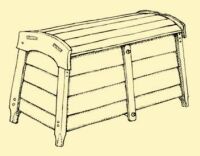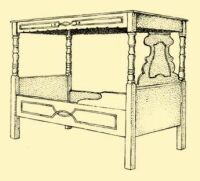| Woodcarving | CONTENTS | Homespun |
Furniture Making
In connection with the furnishing of the house we have already spoken above of the most characteristic types of furniture (cf. pp. 157–63), but we have not touched upon their forms and ornamentation.
The peasant who was able to carve could make the most simple furniture himself, but we know of cabinet makers’ guilds from the Middle Ages, although these did not primarily work for peasants. The cabinet makers who lived in the market towns of the 17th and 18th centuries worked mostly for the nearby peasantry. However, they always maintained a lively contact with the masters who worked for the lords, and were often even apprenticed under them. In the course of their wanderings they not only became acquainted with new furniture forms, but also increased their store of ornamentation.
The oldest type of Hungarian peasant furniture was carved and made with a hewn technique. These are distinguishable from painted furniture, the earliest, undoubtedly peasant-used pieces of which are known from the 18th century.
Baranya County
Baranya County
Nógrád County
We know of two large centres for making hewn chests (ácsolt láda). One form developed in the south-eastern corner of Transdanubia. On each corner of its square top a kind of horn emerges (cf. Ill. 214). Its {383.} ornaments were mostly made with compasses or were linear. These were coloured black; other colours occur sporadically, although mostly on the rather new pieces. The other centre is the north-eastern part of Palócföld, the former Gömör County. Here the lid built on wooden corners is steeply pitched and the four horns are absent. Its ornamentation is always geometrical. Sometimes those triangular human portrayals may be seen that we observed above appearing on staghorns or on herdsmen’s carvings. The works made by the people of Gömör can also be found in various parts of the Great Plain, carried by wandering merchants in a dismantled state. These chests were also hewn in the Székelyland. This is the piece of Hungarian furniture that has the longest history; we can follow its relations all the way to the times before Christ.
Székelyvarság, former Udvarhely County. 1930s
The carved pieces of furniture of the Palotses do not in any way appear to be so old, and their first makers were very likely herdsmen of the second half of the 19th century. The frame of the chair and bench was made of softwood and the carved, open-work panels, portraying various scenes, were fitted into it. Some show stags grazing in the forest, others show entire hunting scenes. There is the shepherd, herding his sheep and playing his bagpipe, the hussar and the honvéd (the soldiers of the 1848–49 War of Independence). In some cases subsequent panels tell an entire story in a surging, peasant-epic manner. Sometimes, although less frequently, cribs, the sides of tables, and plate holders were also decorated in this manner.
Hungary
Nógrád County
Nógrád County
Veszprém County
Tiszafüred, Szolnok County
Zádor, Baranya County
Magyarvalkó, former Kolozs County
Komárom
In Transdanubia, especially in the Bakony, furniture was carved out {387.} of hardwood and decorated with simple intarsia. This was more frequent in the villages inhabited by the lesser nobility, in order to emphasize their belonging to the upper class.
The furniture of Kalotaszeg, which differs from that of the surrounding territories, has chiselled ornamentation, geometric in character, but a looser design which lends it a particular style.
Gyirmót, former Győr County. Second half of 19th century
The ornamental patterns of painted furniture are often rooted in the art of the Renaissance. Thus the choir, pulpit and ceiling paintings of the Calvinist churches (mostly of the 18th century, though a few earlier) had an unquestionable effect on the art of the peasant cabinet makers (cf. Plate XXII, Ill. 41). These occur throughout the entire Hungarian linguistic region, although the most beautiful works of art of the high Renaissance can be found in Transylvania. Tendrils and flowers fill certain panels, and although the motifs are repeated, every one of them is an independent work of art. Their connection with peasant furniture is made even more obvious by the fact that the wandering church painters happily took upon themselves the decorating of chests also, which then could provide immediate examples for the local cabinet makers.
A number of painted furniture centres developed in the Hungarian linguistic region. Several of the more important ones among these are worth mentioning (cf. Plate XXXII). We emphasize Komárom among the ones in Transdanubia, where the front of the chests were carved and smaller flowers and bouquets appeared along the central motif, painted with pale and subdued colours. Through the mediation of sailing the Danube, the chests travelled far south, in many cases even to the Balkans. The masters of Komárom themselves, as famous painters, embellished the ceilings and benches of churches not only in Transdanubia but in the Great Plain as well.
Mid-19th century Nógrád County
Hódmezővásárhely is the most important and most influential among {388.} the furniture making centres of the Great Plain. The wealth of its motifs derives in most cases from the rich ornamentation in late Renaissance style of the local Calvinist church. The basic colour of the furniture is dark, in most cases dark blue, on which primarily red flowers dominate, at some places with paler yellow borders, while the green leaves blend into the dark background almost completely ( cf. Plate XXXIII). The colouring of the neighbouring furniture from Békés County is livelier, and the open-work ornamentation of the chairs and benches differs from that of Hódmezővásárhely. The rich carvings and the open-work are always floral in character, and in many cases show Baroque influence.
In Upper Hungary the furniture painting of Miskolc and Eger was relatively similar. The most colourful pieces were made during the second half of the last century. On the brown, or more frequently red, ground colour were painted red and green and yellow or white and blue bouquets of flowers or wreaths. We often find ears of wheat among the flowers, which are the primary peculiarity of this centre. The basic colour of the furniture of Sátoraljaújhely, which lies in the north-eastern part of Upper Hungary, is black, on which is placed the central motif of a green, yellow, and red-blue bouquet in a vase or box. A garland is substituted for this on other pieces. Painted furniture was still produced here between the two world wars.
Borsod-Abaúj-Zemplén County
The rich ornamental wealth of Torockó stands out even among the numerous cabinet making centres of Transylvania. The basic colour of its products is mostly dark, primarily green, and less frequently blue or {389.} brown. The flower patterns reflect Baroque and Rococo influence and always adjust to the background with blue-white-brown-red-orange colours. The composition is fairly severe, and the endeavour is to fill up the entire surface evenly.
One of the oldest among the numerous centres of painted furniture is Vargyas. The history of one of the cabinet-making families can be traced back to the late 16th century. In the 19th century they painted rich red-blue-yellow bouquets in pitchers, resembling Renaissance style, but wreaths, garlands and birds are also frequently portrayed. Here too, just as at other places, the date of production was written in the centre of the decoration (cf. Plate XXXI). The cabinet makers of Vargyas are still painting chests and other pieces of furniture today.
| Woodcarving | CONTENTS | Homespun |














